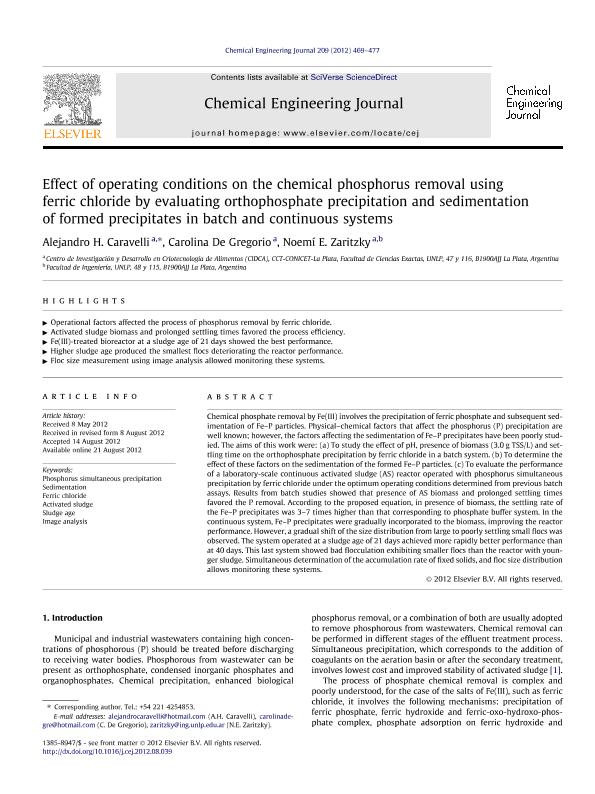Mostrar el registro sencillo del ítem
dc.contributor.author
Caravelli, Alejandro Horacio

dc.contributor.author
de Gregorio, Carolina

dc.contributor.author
Zaritzky, Noemi Elisabet

dc.date.available
2019-09-04T20:10:54Z
dc.date.issued
2012-10-15
dc.identifier.citation
Caravelli, Alejandro Horacio; de Gregorio, Carolina; Zaritzky, Noemi Elisabet; Effect of operating conditions on the chemical phosphorus removal using ferric chloride by evaluating orthophosphate precipitation and sedimentation of formed precipitates in batch and continuous systems; Elsevier Science; Chemical Engineering Journal; 209; 15-10-2012; 469-477
dc.identifier.issn
1385-8947
dc.identifier.uri
http://hdl.handle.net/11336/82923
dc.description.abstract
Chemical phosphate removal by Fe(III) involves the precipitation of ferric phosphate and subsequent sedimentation of Fe-P particles. Physical-chemical factors that affect the phosphorus (P) precipitation are well known; however, the factors affecting the sedimentation of Fe-P precipitates have been poorly studied. The aims of this work were: (a) To study the effect of pH, presence of biomass (3.0. g TSS/L) and settling time on the orthophosphate precipitation by ferric chloride in a batch system. (b) To determine the effect of these factors on the sedimentation of the formed Fe-P particles. (c) To evaluate the performance of a laboratory-scale continuous activated sludge (AS) reactor operated with phosphorus simultaneous precipitation by ferric chloride under the optimum operating conditions determined from previous batch assays. Results from batch studies showed that presence of AS biomass and prolonged settling times favored the P removal. According to the proposed equation, in presence of biomass, the settling rate of the Fe-P precipitates was 3-7 times higher than that corresponding to phosphate buffer system. In the continuous system, Fe-P precipitates were gradually incorporated to the biomass, improving the reactor performance. However, a gradual shift of the size distribution from large to poorly settling small flocs was observed. The system operated at a sludge age of 21. days achieved more rapidly better performance than at 40. days. This last system showed bad flocculation exhibiting smaller flocs than the reactor with younger sludge. Simultaneous determination of the accumulation rate of fixed solids, and floc size distribution allows monitoring these systems.
dc.format
application/pdf
dc.language.iso
eng
dc.publisher
Elsevier Science

dc.rights
info:eu-repo/semantics/openAccess
dc.rights.uri
https://creativecommons.org/licenses/by-nc-nd/2.5/ar/
dc.subject
Phosphorus Simultaneous Precipitation
dc.subject
Sedimentation
dc.subject
Ferric Chloride
dc.subject
Activated Sludge
dc.subject
Sludge Age
dc.subject
Image Analysis
dc.subject.classification
Otras Ingeniería del Medio Ambiente

dc.subject.classification
Ingeniería del Medio Ambiente

dc.subject.classification
INGENIERÍAS Y TECNOLOGÍAS

dc.title
Effect of operating conditions on the chemical phosphorus removal using ferric chloride by evaluating orthophosphate precipitation and sedimentation of formed precipitates in batch and continuous systems
dc.type
info:eu-repo/semantics/article
dc.type
info:ar-repo/semantics/artículo
dc.type
info:eu-repo/semantics/publishedVersion
dc.date.updated
2019-04-26T18:21:26Z
dc.journal.volume
209
dc.journal.pagination
469-477
dc.journal.pais
Países Bajos

dc.journal.ciudad
Amsterdam
dc.description.fil
Fil: Caravelli, Alejandro Horacio. Provincia de Buenos Aires. Gobernación. Comisión de Investigaciones Científicas. Centro de Investigación y Desarrollo en Criotecnología de Alimentos. Consejo Nacional de Investigaciones Científicas y Técnicas. Centro Científico Tecnológico Conicet - La Plata. Centro de Investigación y Desarrollo en Criotecnología de Alimentos. Universidad Nacional de la Plata. Facultad de Ciencias Exactas. Centro de Investigación y Desarrollo en Criotecnología de Alimentos; Argentina
dc.description.fil
Fil: de Gregorio, Carolina. Provincia de Buenos Aires. Gobernación. Comisión de Investigaciones Científicas. Centro de Investigación y Desarrollo en Criotecnología de Alimentos. Consejo Nacional de Investigaciones Científicas y Técnicas. Centro Científico Tecnológico Conicet - La Plata. Centro de Investigación y Desarrollo en Criotecnología de Alimentos. Universidad Nacional de la Plata. Facultad de Ciencias Exactas. Centro de Investigación y Desarrollo en Criotecnología de Alimentos; Argentina
dc.description.fil
Fil: Zaritzky, Noemi Elisabet. Provincia de Buenos Aires. Gobernación. Comisión de Investigaciones Científicas. Centro de Investigación y Desarrollo en Criotecnología de Alimentos. Consejo Nacional de Investigaciones Científicas y Técnicas. Centro Científico Tecnológico Conicet - La Plata. Centro de Investigación y Desarrollo en Criotecnología de Alimentos. Universidad Nacional de la Plata. Facultad de Ciencias Exactas. Centro de Investigación y Desarrollo en Criotecnología de Alimentos; Argentina
dc.journal.title
Chemical Engineering Journal

dc.relation.alternativeid
info:eu-repo/semantics/altIdentifier/url/http://www.sciencedirect.com/science/article/pii/S1385894712010935
dc.relation.alternativeid
info:eu-repo/semantics/altIdentifier/doi/http://dx.doi.org/10.1016/j.cej.2012.08.039
Archivos asociados
